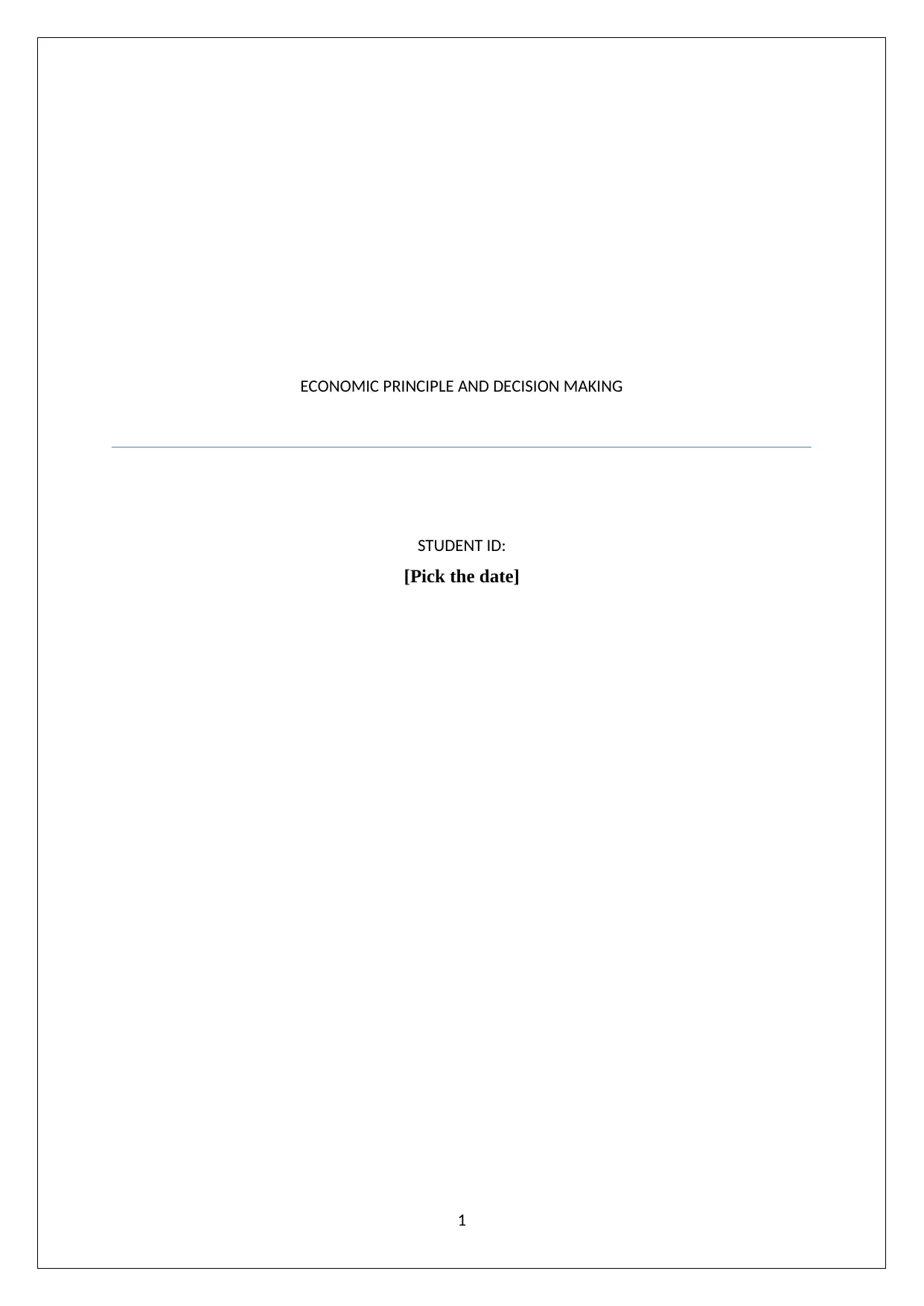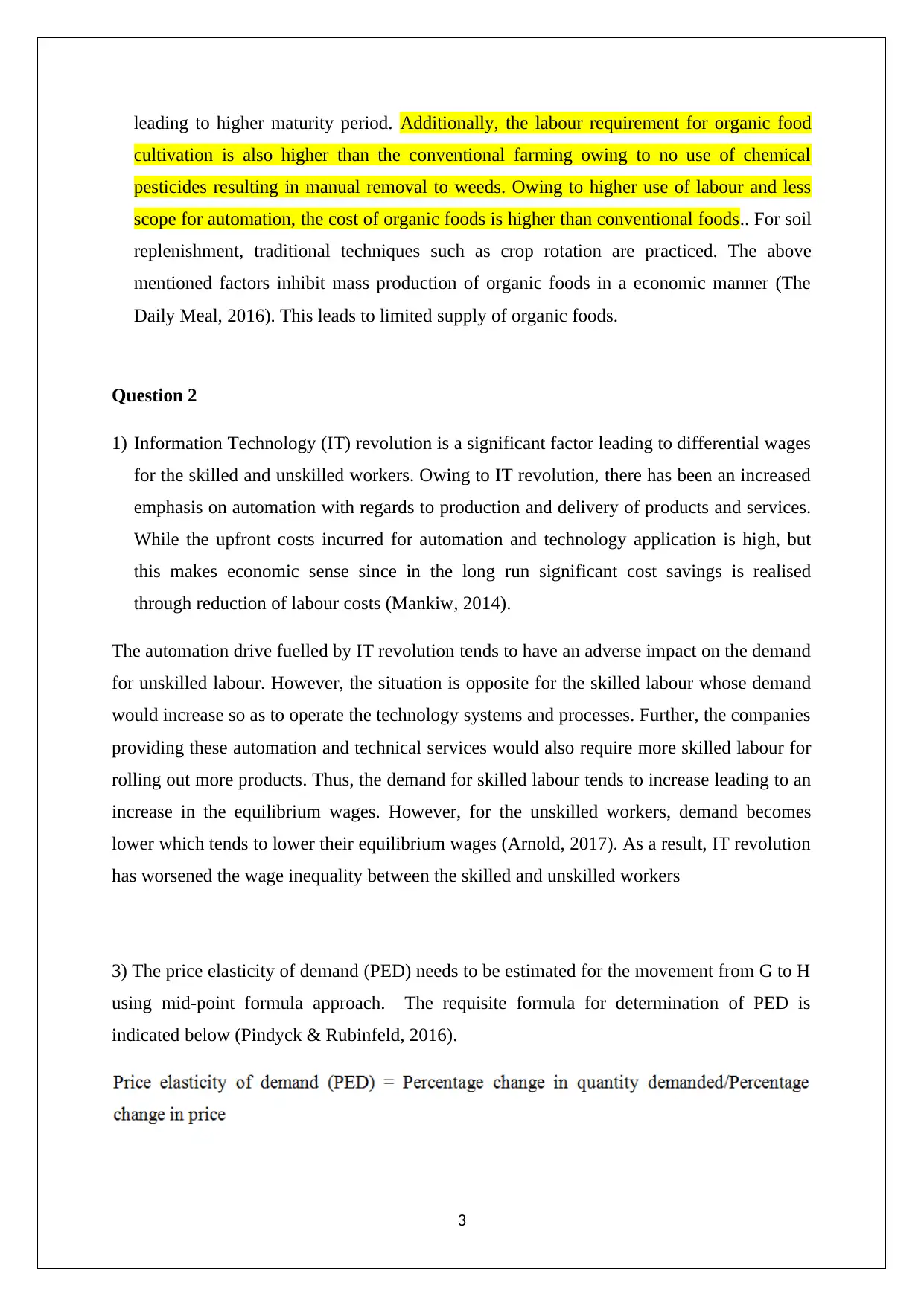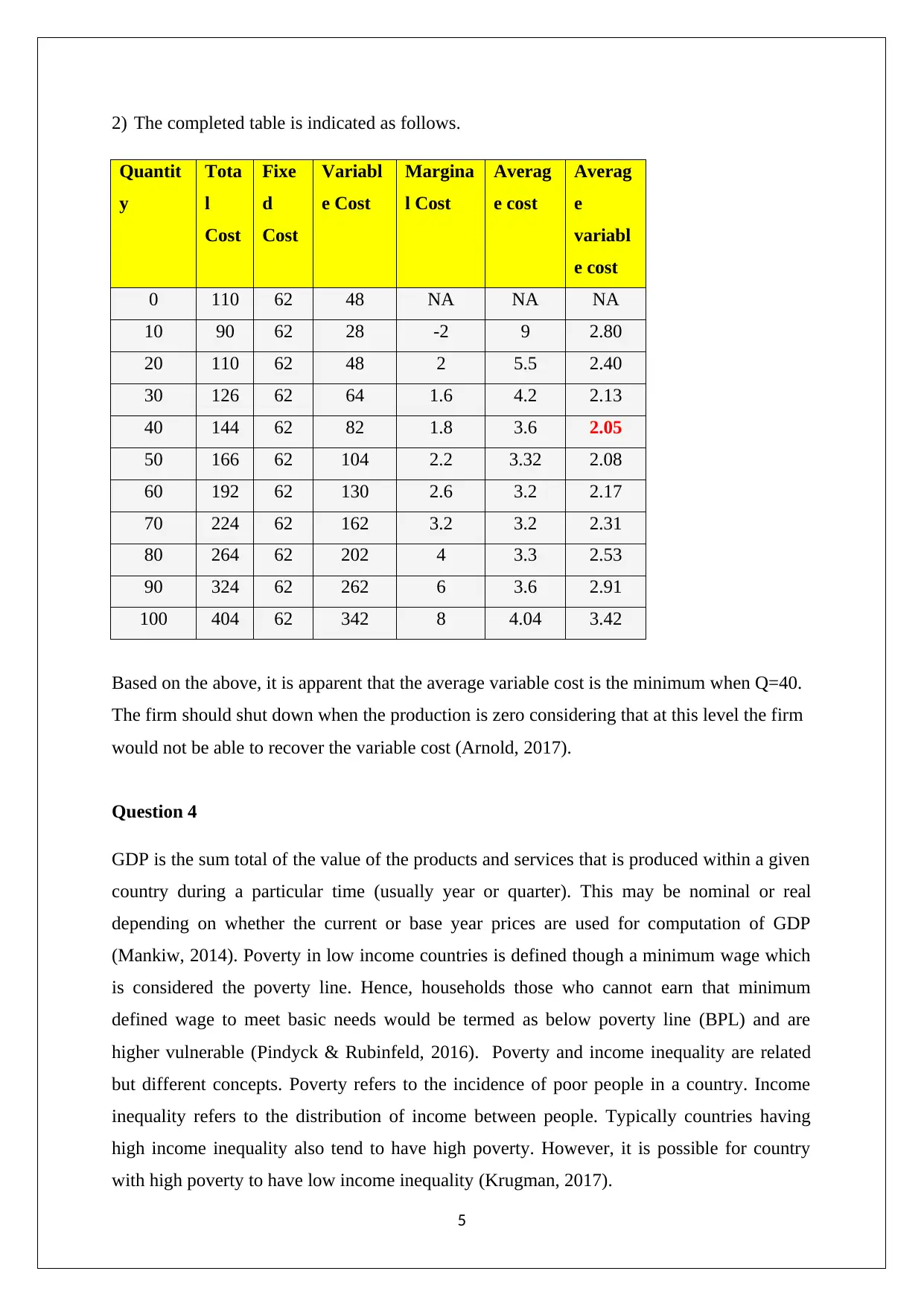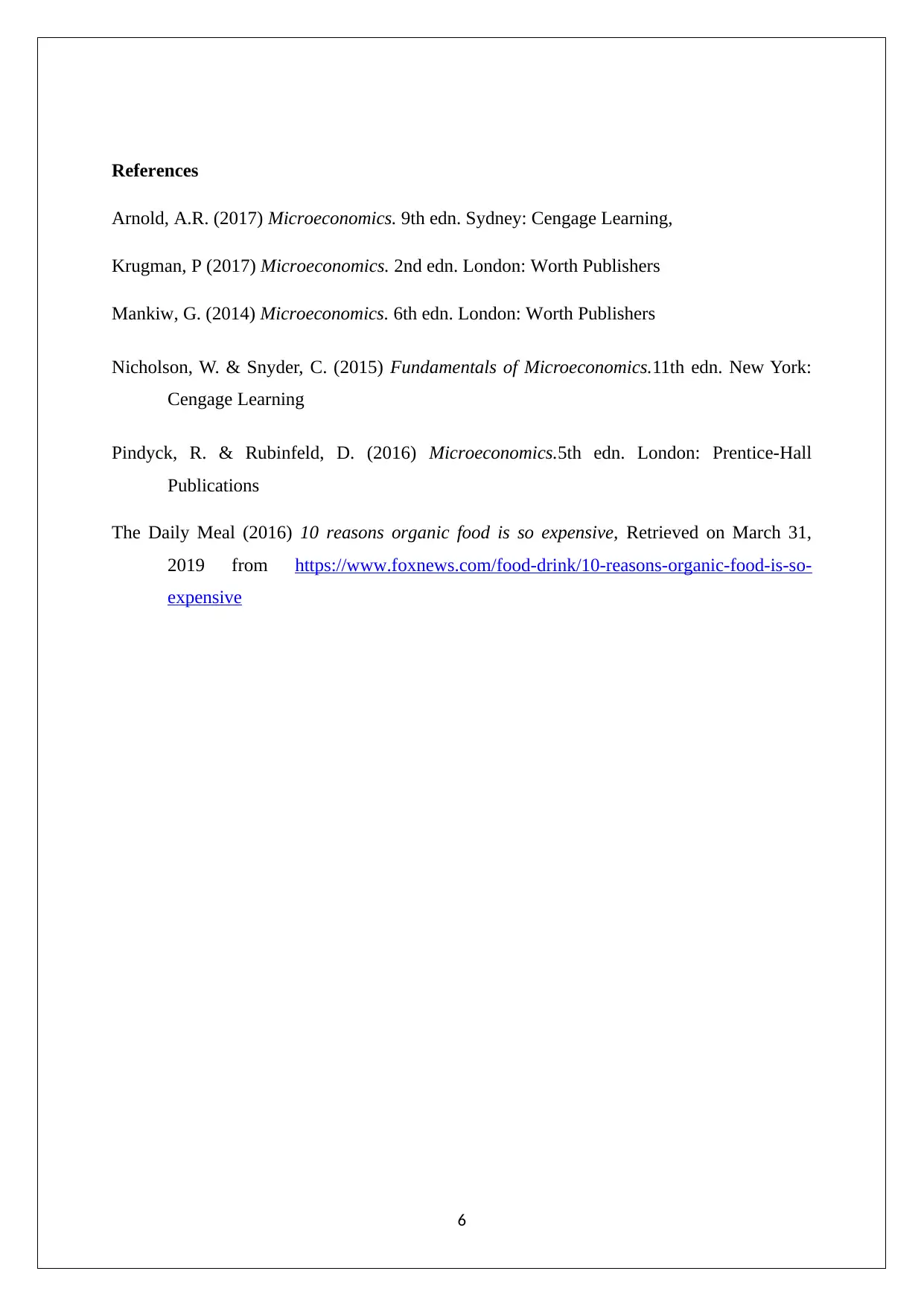Economic Principles and Decision Making Assignment - Semester 1
VerifiedAdded on 2023/01/12
|6
|1362
|52
Homework Assignment
AI Summary
This economics assignment delves into several key economic principles. It begins by examining the law of demand using a normal good like noodles, exploring how changes in income affect consumption. The assignment then investigates the factors influencing the supply and cost of organic foods. A significant portion focuses on the impact of the Information Technology revolution on wage inequality between skilled and unskilled workers, along with an analysis of price elasticity of demand using the midpoint formula. The assignment further explores economies of scale, using cities as an example, and analyzes a cost table to determine a firm's shutdown point. Finally, it touches upon the concepts of GDP, poverty, and income inequality, clarifying their relationships and differences. The assignment provides detailed answers to the questions posed in the brief, supported by economic theories and relevant examples.

ECONOMIC PRINCIPLE AND DECISION MAKING
STUDENT ID:
[Pick the date]
1
STUDENT ID:
[Pick the date]
1
Paraphrase This Document
Need a fresh take? Get an instant paraphrase of this document with our AI Paraphraser

Question 1
1) A good which follows the law of demand is termed as normal good. As per the law of
demand, there is an inverse relationship between the price and demand of the good. As a
result, the demand curve would be downward sloping (Arnold, 2017). Considering the
above , the demand curve for a normal good such as noodle is indicated as follows.
In the demand curve shown above, the quantity demanded is denoted by Q on the horizontal
axis whereas the price is represented on the vertical axis. It is evident that as the price
decreases there is an increase in the quantity demanded.
2) The impact of changing income levels with regards to noodles purchase would depend on
the income elasticity. In case of normal goods, typically higher income leads to higher
quantity demanded of normal goods. This is on expected lines as increase in income
would reply higher availability of financial resources to make the purchase of goods. Thus,
with increasing income levels, affordability of a given good improves resulting in higher
consumption (Krugman, 2017). As a result, for noodles it is fair to expect that as income
increases, the consumers would purchase more noodles.
3) The demand for organic foods has increased in the recent times as consumers have started
realising the health benefits associated with the consumption of organic foods. However,
the supply of organic foods has not been to catch up with the increased demand primarily
on account of the production techniques involved. Since organic foods can only use
organic fertilisers, hence the growth is comparatively lower than with chemical fertilisers
2
1) A good which follows the law of demand is termed as normal good. As per the law of
demand, there is an inverse relationship between the price and demand of the good. As a
result, the demand curve would be downward sloping (Arnold, 2017). Considering the
above , the demand curve for a normal good such as noodle is indicated as follows.
In the demand curve shown above, the quantity demanded is denoted by Q on the horizontal
axis whereas the price is represented on the vertical axis. It is evident that as the price
decreases there is an increase in the quantity demanded.
2) The impact of changing income levels with regards to noodles purchase would depend on
the income elasticity. In case of normal goods, typically higher income leads to higher
quantity demanded of normal goods. This is on expected lines as increase in income
would reply higher availability of financial resources to make the purchase of goods. Thus,
with increasing income levels, affordability of a given good improves resulting in higher
consumption (Krugman, 2017). As a result, for noodles it is fair to expect that as income
increases, the consumers would purchase more noodles.
3) The demand for organic foods has increased in the recent times as consumers have started
realising the health benefits associated with the consumption of organic foods. However,
the supply of organic foods has not been to catch up with the increased demand primarily
on account of the production techniques involved. Since organic foods can only use
organic fertilisers, hence the growth is comparatively lower than with chemical fertilisers
2

leading to higher maturity period. Additionally, the labour requirement for organic food
cultivation is also higher than the conventional farming owing to no use of chemical
pesticides resulting in manual removal to weeds. Owing to higher use of labour and less
scope for automation, the cost of organic foods is higher than conventional foods.. For soil
replenishment, traditional techniques such as crop rotation are practiced. The above
mentioned factors inhibit mass production of organic foods in a economic manner (The
Daily Meal, 2016). This leads to limited supply of organic foods.
Question 2
1) Information Technology (IT) revolution is a significant factor leading to differential wages
for the skilled and unskilled workers. Owing to IT revolution, there has been an increased
emphasis on automation with regards to production and delivery of products and services.
While the upfront costs incurred for automation and technology application is high, but
this makes economic sense since in the long run significant cost savings is realised
through reduction of labour costs (Mankiw, 2014).
The automation drive fuelled by IT revolution tends to have an adverse impact on the demand
for unskilled labour. However, the situation is opposite for the skilled labour whose demand
would increase so as to operate the technology systems and processes. Further, the companies
providing these automation and technical services would also require more skilled labour for
rolling out more products. Thus, the demand for skilled labour tends to increase leading to an
increase in the equilibrium wages. However, for the unskilled workers, demand becomes
lower which tends to lower their equilibrium wages (Arnold, 2017). As a result, IT revolution
has worsened the wage inequality between the skilled and unskilled workers
3) The price elasticity of demand (PED) needs to be estimated for the movement from G to H
using mid-point formula approach. The requisite formula for determination of PED is
indicated below (Pindyck & Rubinfeld, 2016).
3
cultivation is also higher than the conventional farming owing to no use of chemical
pesticides resulting in manual removal to weeds. Owing to higher use of labour and less
scope for automation, the cost of organic foods is higher than conventional foods.. For soil
replenishment, traditional techniques such as crop rotation are practiced. The above
mentioned factors inhibit mass production of organic foods in a economic manner (The
Daily Meal, 2016). This leads to limited supply of organic foods.
Question 2
1) Information Technology (IT) revolution is a significant factor leading to differential wages
for the skilled and unskilled workers. Owing to IT revolution, there has been an increased
emphasis on automation with regards to production and delivery of products and services.
While the upfront costs incurred for automation and technology application is high, but
this makes economic sense since in the long run significant cost savings is realised
through reduction of labour costs (Mankiw, 2014).
The automation drive fuelled by IT revolution tends to have an adverse impact on the demand
for unskilled labour. However, the situation is opposite for the skilled labour whose demand
would increase so as to operate the technology systems and processes. Further, the companies
providing these automation and technical services would also require more skilled labour for
rolling out more products. Thus, the demand for skilled labour tends to increase leading to an
increase in the equilibrium wages. However, for the unskilled workers, demand becomes
lower which tends to lower their equilibrium wages (Arnold, 2017). As a result, IT revolution
has worsened the wage inequality between the skilled and unskilled workers
3) The price elasticity of demand (PED) needs to be estimated for the movement from G to H
using mid-point formula approach. The requisite formula for determination of PED is
indicated below (Pindyck & Rubinfeld, 2016).
3
⊘ This is a preview!⊘
Do you want full access?
Subscribe today to unlock all pages.

Trusted by 1+ million students worldwide

The % quantity change would be determined based on the formula given below considering
the mid-point approach.
The % price change would be determined based on the formula given below considering the
mid-point approach
Taking into consideration the above steps, PED = (-11.76/8) = -1.47
Based on the result above, it is appropriate to conclude that PED has increased in magnitude
to 1.47 from G to H. A PED magnitude in excess of 1 also indicates elastic demand between
G and H.
Question 3
1) Cities can be viewed as an example of economies of scale. This is because with regards to
setting up of cities, there is a high fixed cost in terms of the infrastructure requirement.
Additionally, there is variable cost associated with the service providers of different
essential services which are required for the residents. As the number of residents
increases in the city, the variable cost per resident for essential services would continue to
come down. Also, with the increased resident count, the fixed cost per resident for the
enabling infrastructure would also decline. This leads to lowering average total cost per
resident with the increasing residents number in the city which indicates cost savings on
account of economies of scale (Nicholson & Snyder, 2015).
4
the mid-point approach.
The % price change would be determined based on the formula given below considering the
mid-point approach
Taking into consideration the above steps, PED = (-11.76/8) = -1.47
Based on the result above, it is appropriate to conclude that PED has increased in magnitude
to 1.47 from G to H. A PED magnitude in excess of 1 also indicates elastic demand between
G and H.
Question 3
1) Cities can be viewed as an example of economies of scale. This is because with regards to
setting up of cities, there is a high fixed cost in terms of the infrastructure requirement.
Additionally, there is variable cost associated with the service providers of different
essential services which are required for the residents. As the number of residents
increases in the city, the variable cost per resident for essential services would continue to
come down. Also, with the increased resident count, the fixed cost per resident for the
enabling infrastructure would also decline. This leads to lowering average total cost per
resident with the increasing residents number in the city which indicates cost savings on
account of economies of scale (Nicholson & Snyder, 2015).
4
Paraphrase This Document
Need a fresh take? Get an instant paraphrase of this document with our AI Paraphraser

2) The completed table is indicated as follows.
Quantit
y
Tota
l
Cost
Fixe
d
Cost
Variabl
e Cost
Margina
l Cost
Averag
e cost
Averag
e
variabl
e cost
0 110 62 48 NA NA NA
10 90 62 28 -2 9 2.80
20 110 62 48 2 5.5 2.40
30 126 62 64 1.6 4.2 2.13
40 144 62 82 1.8 3.6 2.05
50 166 62 104 2.2 3.32 2.08
60 192 62 130 2.6 3.2 2.17
70 224 62 162 3.2 3.2 2.31
80 264 62 202 4 3.3 2.53
90 324 62 262 6 3.6 2.91
100 404 62 342 8 4.04 3.42
Based on the above, it is apparent that the average variable cost is the minimum when Q=40.
The firm should shut down when the production is zero considering that at this level the firm
would not be able to recover the variable cost (Arnold, 2017).
Question 4
GDP is the sum total of the value of the products and services that is produced within a given
country during a particular time (usually year or quarter). This may be nominal or real
depending on whether the current or base year prices are used for computation of GDP
(Mankiw, 2014). Poverty in low income countries is defined though a minimum wage which
is considered the poverty line. Hence, households those who cannot earn that minimum
defined wage to meet basic needs would be termed as below poverty line (BPL) and are
higher vulnerable (Pindyck & Rubinfeld, 2016). Poverty and income inequality are related
but different concepts. Poverty refers to the incidence of poor people in a country. Income
inequality refers to the distribution of income between people. Typically countries having
high income inequality also tend to have high poverty. However, it is possible for country
with high poverty to have low income inequality (Krugman, 2017).
5
Quantit
y
Tota
l
Cost
Fixe
d
Cost
Variabl
e Cost
Margina
l Cost
Averag
e cost
Averag
e
variabl
e cost
0 110 62 48 NA NA NA
10 90 62 28 -2 9 2.80
20 110 62 48 2 5.5 2.40
30 126 62 64 1.6 4.2 2.13
40 144 62 82 1.8 3.6 2.05
50 166 62 104 2.2 3.32 2.08
60 192 62 130 2.6 3.2 2.17
70 224 62 162 3.2 3.2 2.31
80 264 62 202 4 3.3 2.53
90 324 62 262 6 3.6 2.91
100 404 62 342 8 4.04 3.42
Based on the above, it is apparent that the average variable cost is the minimum when Q=40.
The firm should shut down when the production is zero considering that at this level the firm
would not be able to recover the variable cost (Arnold, 2017).
Question 4
GDP is the sum total of the value of the products and services that is produced within a given
country during a particular time (usually year or quarter). This may be nominal or real
depending on whether the current or base year prices are used for computation of GDP
(Mankiw, 2014). Poverty in low income countries is defined though a minimum wage which
is considered the poverty line. Hence, households those who cannot earn that minimum
defined wage to meet basic needs would be termed as below poverty line (BPL) and are
higher vulnerable (Pindyck & Rubinfeld, 2016). Poverty and income inequality are related
but different concepts. Poverty refers to the incidence of poor people in a country. Income
inequality refers to the distribution of income between people. Typically countries having
high income inequality also tend to have high poverty. However, it is possible for country
with high poverty to have low income inequality (Krugman, 2017).
5

References
Arnold, A.R. (2017) Microeconomics. 9th edn. Sydney: Cengage Learning,
Krugman, P (2017) Microeconomics. 2nd edn. London: Worth Publishers
Mankiw, G. (2014) Microeconomics. 6th edn. London: Worth Publishers
Nicholson, W. & Snyder, C. (2015) Fundamentals of Microeconomics.11th edn. New York:
Cengage Learning
Pindyck, R. & Rubinfeld, D. (2016) Microeconomics.5th edn. London: Prentice-Hall
Publications
The Daily Meal (2016) 10 reasons organic food is so expensive, Retrieved on March 31,
2019 from https://www.foxnews.com/food-drink/10-reasons-organic-food-is-so-
expensive
6
Arnold, A.R. (2017) Microeconomics. 9th edn. Sydney: Cengage Learning,
Krugman, P (2017) Microeconomics. 2nd edn. London: Worth Publishers
Mankiw, G. (2014) Microeconomics. 6th edn. London: Worth Publishers
Nicholson, W. & Snyder, C. (2015) Fundamentals of Microeconomics.11th edn. New York:
Cengage Learning
Pindyck, R. & Rubinfeld, D. (2016) Microeconomics.5th edn. London: Prentice-Hall
Publications
The Daily Meal (2016) 10 reasons organic food is so expensive, Retrieved on March 31,
2019 from https://www.foxnews.com/food-drink/10-reasons-organic-food-is-so-
expensive
6
⊘ This is a preview!⊘
Do you want full access?
Subscribe today to unlock all pages.

Trusted by 1+ million students worldwide
1 out of 6
Related Documents
Your All-in-One AI-Powered Toolkit for Academic Success.
+13062052269
info@desklib.com
Available 24*7 on WhatsApp / Email
![[object Object]](/_next/static/media/star-bottom.7253800d.svg)
Unlock your academic potential
Copyright © 2020–2025 A2Z Services. All Rights Reserved. Developed and managed by ZUCOL.



